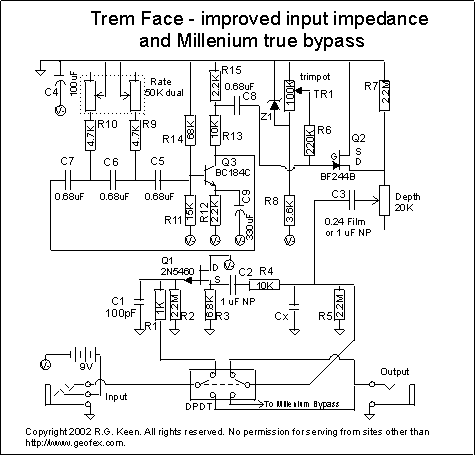| Still, there are some problems with the
design, at least by modern standards. It had a low input impedance,
and no true bypass provisions. "Bypass" is done by flipping
the switch to set a constant attenuation on the input signal instead of
a varying one. I decided that I could go the Trem Face one better.
That's what's in this third schematic.
In this one, I've added a JFET source follower to buffer the input signal, and a Millenium Bypass to get true bypass with a DPDT stomp switch. This makes the thing a much more palatable device for modern tastes. It's worth noting that the JFET is a p-channel. I chose that because (a) it keeps the signal referenced to ground instead of the floating negative power supply as would have happened with an N-channel JFET and (b) it simplified the circuit a lot. I picked the 2N5460 because it is readily available from Mouser Electronics and inexpensive. Most P-channel JFETs should work OK in this circuit, although you might have to select from a couple of different ones, as there is a wide range of parameters on JFETs. I've added an RF suppression network, R1/C1 to the input to help kill off radio pickup. You may have seen FET circuits with capacitors to ground at the input before. This may work, but it also may not. Depending on the frequency and a bunch of other RF-magic conditions, adding only a capacitor to the input of a high impedance stage may make RF interference *worse* by helping tune the interfering signal, and converting it to a lower impedance. Adding a series resistor before the cap insures that the cap cannot tune the interference and that it does in fact reduce the signal level by causing attenuation through the R1/C1 divider that this forms. I also modified the bias circuit a bit. I made the adjustment pot 100K, because 1M trimmers are hard to find, and even Radio Shack has 100K trimmers. The 1M trimmer presented an impedance of about 250K to the signal through C8, so I stuck a 220K resistor in series with the trimpot wiper to get the impedance up. This proved to work fine on Ed's units. I haven't had a chance to true-bypass this thing yet. I suspect that when I do, it will uncover the common flaw in most older effects converted to true bypass - signal drop in the effect mode. I'm betting that I'll have to diddle with the input JFET to make it have a little gain, maybe two to four, so that the perceived loudness when the effect is engaged is the same as that when it's bypassed. The older effects didn't make the loudness seem different because they also attenuated the "bypassed" signal by not really bypassing it. Both effect and non-effect sound were lower level, so the change was not obvious. |
